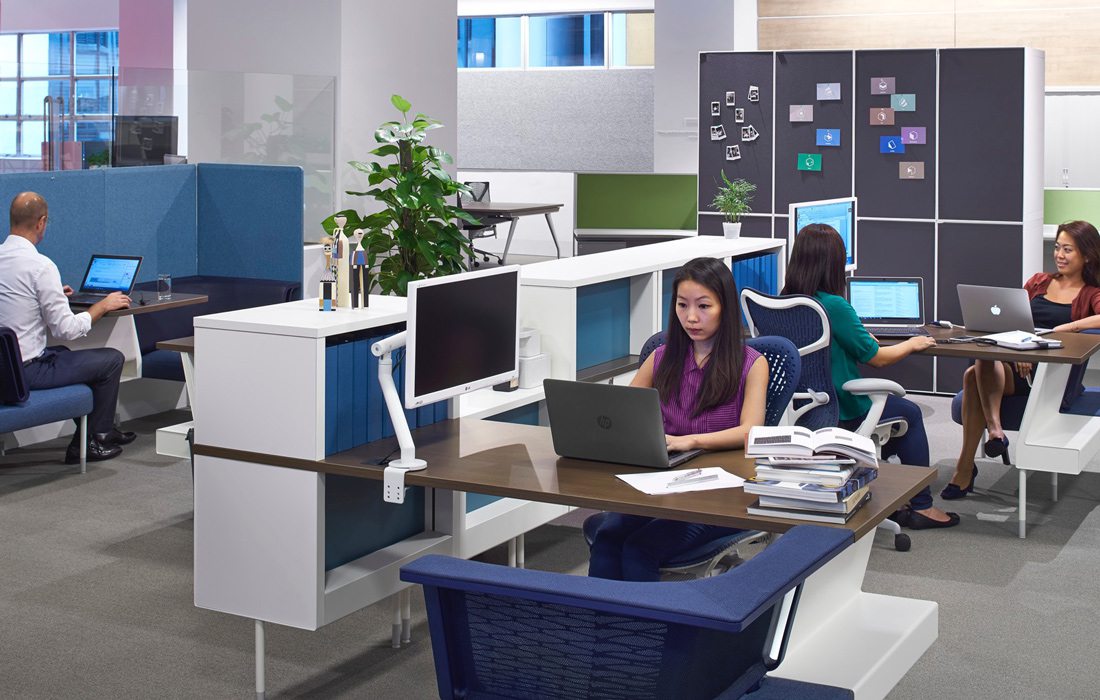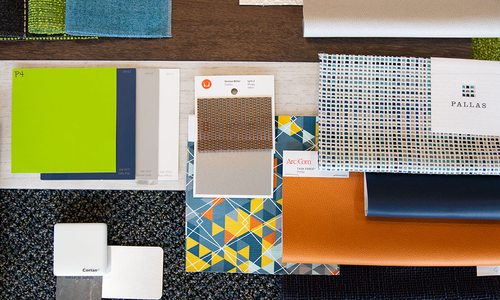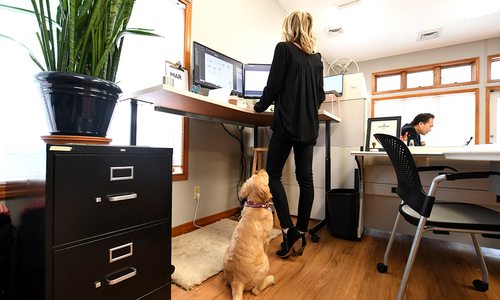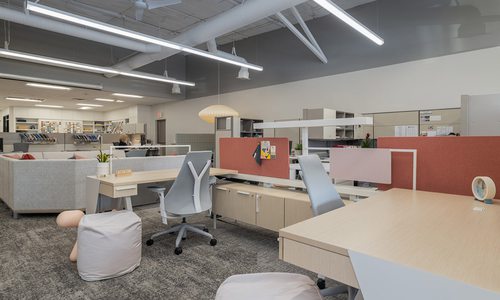
Culture
What Your Office Furniture Says About Your Culture
Next time performance reports come around, don’t forget to rate one of the biggest players—your office furniture. Uncomfortable chairs, boring meeting spaces and poorly designed layouts might be hurting your office’s productivity and culture.
By Ettie Berneking
Sep 19 2019 at 10:17 a.m.

You can’t create workplace culture by talking about it. You have to take action. Don’t just talk about implementing productivity reviews, dedicate time and space for them. Don’t just complain about how dirty the office fridge is, schedule a weekly cleanup! Armed with an arsenal of tips, Don Harkey of People Centric Consulting Group talks strategy for kickstarting a better workplace culture and accomplishing office goals while Victoria Gorham, sales manager at Grooms Office Environments, explains how your office design and furnishing can either help you meet those goals or set you up for failure.
PRESENTED BY
Problem: Teams don’t feel like they can speak freely or creatively
Solution: Create dedicated meeting spaces
Don Harkey: Open communication can be tough when your team doesn’t have dedicated time and space to talk about issues, opportunities or challenges. Don’t make them stress about interrupting you or worry about scheduling a meeting to talk things through. Instead, dedicate a time and place to have these conversations regularly. This means adding a recurring meeting to your schedule and picking a place to gather. It can be your office, the kitchen, a breakout meeting space, a coffee shop, whatever it needs to be.
Victoria Gorham: Planning for smaller meetings spaces within your office building when redesigning is key. Many people don’t want to take up an entire conference room for a two-person meeting, so they tend to have calls or conversations at their desks, which ends up distracting their coworkers. This is where creating smaller meeting spaces can help. These smaller spaces do not have to be defined by four walls though. They could be a high back booth area or an architectural feature that provides a little bit of separation. This kind of feature is useful for employees who need a place to spread out their work away from their desk or who want an alternative for lunch with a coworker.

Problem: Departments are disengaged with each other
Solution: Remove barriers
D.H.: Another big tip is getting your people involved across departments. People can become siloed, which leads to them not understanding or appreciating what other members of the team are up to. Make sure you dedicate time to highlight successes of each department, so everyone across the board has an understanding of how each department contributes to the business’s overall success.
V.G.: This is a big reason open offices have grown in popularity. They eliminate the physical separation between departments and can open up interaction and communication. An open office space can connect team members and allow them to get questions answered quickly. One thing we recommend to clients who want to incorporate open office elements, is considering where each department manager will be located. When the manger is right next to you and can hear how you handle a call, they are able to step in when needed or more accurately give you a performance review when the time comes. Integrating management into the open office setting needs to be juggled well, though. Allowing those members to be able to contribute to the team, socialize with employees but also have spaces to have private conversations and make sure their work is getting done needs to be considered when programming how the space should be designed.
Problem: Your team isn’t motivated to act on big-picture goals
Solution: Get your team involved with the business strategy
D.H.: A key component of a successful culture is making sure everyone knows what winning looks like and what they need to focus on that will drive the performance of the company. Having common objectives and scoreboards displayed around the office is a really effective way of getting engagement and building accountability. Teams own what they help create.
V.G.: Visual motivation is proven to work! There are ways to add touches throughout your office to call attention where you want it, whether that’s to a sales goal you’re trying to reach or a spotlight on a factory lineman who came up with an idea to increase efficiency. These visuals can simply be a whiteboard in the break room to call these items out. But you can also use visual reminders like these to encourage and engage your team with company-wide goals. If your team is working on reaching a sales or performance goal, maybe tie it into an office update like a new break room that has comfy seating and is a place to relax and unwind. Have your employees work toward a goal and reward them for it while upgrading your space for the long term. This will be a continuously tangible reminder of the effort everyone worked together to obtain.
“Culture just happens. It’s what it’s like to work there. It’s set by everybody; some of it accidentally and some of it intentionally.”— Don Harkey, People Centric Consulting Group

Problem: Your office lacks pizzazz
Solution: Poll your team about what they want and encourage creativity
D.H.: This is directly related to space. I heard Jonathan Garard of Grooms speak about culture, and how you should have your team help you create the office space. If your folks help drive what the office looks like, they will also own that. A lot of people think if they put in a ping pong table, that will drive culture, but no. Culture just happens. It’s what it’s like to work there. It’s set by everybody; some of it accidentally and some of it intentionally.
V.G.: It’s very true that if your employee takes pride in the space they spend a third of their life at, then they’ll treat it with more respect and have a more meaningful connection to it. Encourage your employees to share what they think can be improved, big or small. A sit-to-stand desk or a better coffee maker can be simple changes that can boost morale and make employees feel like their input matters. Looking to repaint or install new carpet? Have a professional develop two schemes and let your employees vote. Just be warned, you’ll never have everyone agree on the same one.
Problem: You have a great team, but they’re not performing well
Solution: Put people in the right positions
D.H.: Making sure you get the right people in the right places is also key to culture. It starts with the performance of the company. If the company isn’t selling enough, then you look at the sales team. Are you missing tools to help them, or is it the team members themselves? The good thing is most people know if they’re in the wrong place. Maybe they’re not hardwired for that position. To figure out if someone is in the right place, you have to evaluate two things: You look at culture fit and job fit. Your team member might be a great cultural fit, but they might be struggling in the job. If this is the case, you might have an opportunity to move them to a new position. If they’re a bad cultural fit, that’s harder. That can infect the team.
V.G.: Management has a constant duty of making sure their employees are functioning at the most efficient speed and accuracy for their job. Making sure the right people are in the right position extends to the physical office setting you’re providing for them. Does HR have enough privacy to handle confidential conversations with employees or a space that invites the employee to approach them? Does your sales team have enough sound absorbing materials around them so they can make calls without being distracted? Consciously thinking of these functions performed by different jobs and planning around them will give your people the tools they need to do their job best.
About Grooms Office Environments: For more than 40 years, Grooms Office Environments has provided commercial interior design services including space planning, project and move management, healthcare and systems furniture as a full-service Herman Miller dealership. Whether you need to furnish a single office, a new building or even a single meeting space, Grooms’ expertise can work for you. Grooms clients include Jack Henry, Prime Trucking, Oak Star Bank and CoxHealth Network.













